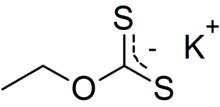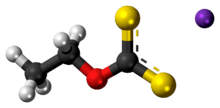Potassium ethyl xanthate
 | |
 | |
| Names | |
|---|---|
| IUPAC name
potassium O-ethylcarbonodithioate | |
| Other names
potassium ethylxanthogenate potassium-O-ethyl dithiocarbonate | |
| Identifiers | |
3D model (JSmol) |
|
| ChemSpider | |
| ECHA InfoCard | 100.004.946 |
PubChem CID |
|
| |
| |
| Properties | |
| C3H5KOS2 | |
| Molar mass | 160.29 g·mol−1 |
| Appearance | Pale yellow powder |
| Density | 1.263 g/cm3[1] |
| Melting point | 225 to 226 °C (437 to 439 °F; 498 to 499 K) |
| Boiling point | decomposes |
| Acidity (pKa) | approximately 1.6 |
| Hazards | |
| R-phrases (outdated) | R15 R21 R22 R29 R36 R38 |
| S-phrases (outdated) | S3 S9 S35 S36 S37 S38 S39 S16 S23 S51 |
Except where otherwise noted, data are given for materials in their standard state (at 25 °C [77 °F], 100 kPa). | |
| Infobox references | |
Potassium ethyl xanthate (KEX) is an organosulfur compound with the chemical formula CH3CH2OCS2K. It is a pale yellow powder that is used in the mining industry for the separation of ores. Unlike the related sodium ethyl xanthate, the potassium salt exists as an anhydrous salt.
Production and properties
Xanthate salts are prepared by the action of alkoxides on carbon disulfide. The alkoxide is often generated in situ from potassium hydroxide:[2]
- CH3CH2OH + CS2 + KOH → CH3CH2OCS2K + H2O
Potassium ethyl xanthate is a pale yellow powder that is stable at high pH but rapidly hydrolyses at pH <9 at 25 °C. Unlike the sodium derivative, potassium xanthate crystallizes as the anhydrous salt and is nonhygroscopic.
Applications
Potassium ethyl xanthate is used in the mining industry as flotation agent for extraction of the ores of copper, nickel, and silver.[3] The method exploits the affinity of these "soft" metals for the organosulfur ligand.
Potassium xanthate is a useful reagent for preparing xanthate esters from alkyl and aryl halides. The resulting xanthate estes are useful intermediates in organic synthesis.[4]
Safety
The LD50 is 683 mg/kg (oral, rats) for potassium ethyl xanthate.[3]
References
- ↑ Report 5 (1995) p. 5
- ↑ This report gives a detailed procedure Charles C. Price and Gardner W. Stacy (1948). "p-nitrophenyl) sulfide". Organic Syntheses. 28: 82. ; Collective Volume, 3, p. 667
- 1 2 Kathrin-Maria Roy (2005). "Xanthates". Ullmann's Encyclopedia of Industrial Chemistry. Weinheim: Wiley-VCH. doi:10.1002/14356007.a28_423.
- ↑ One of several procedures using xanthate esters: Fabien Gagosz and Samir Z. Zard (1948). "A Xanthate-Transfer Approach to α-Trifluoromethylamines". Organic Syntheses. 84: 32. ; Collective Volume, 11, p. 212